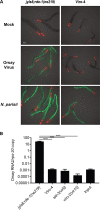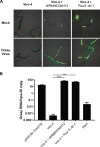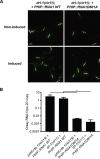The Dietary Restriction-Like Gene drl-1, Which Encodes a Putative Serine/Threonine Kinase, Is Essential for Orsay Virus Infection in Caenorhabditis elegans
- PMID: 30429346
- PMCID: PMC6340041
- DOI: 10.1128/JVI.01400-18
The Dietary Restriction-Like Gene drl-1, Which Encodes a Putative Serine/Threonine Kinase, Is Essential for Orsay Virus Infection in Caenorhabditis elegans
Abstract
Orsay virus is the only known natural virus pathogen of Caenorhabditis elegans, and its discovery has enabled virus-host interaction studies in this model organism. Host genes required for viral infection remain understudied. We previously established a forward genetic screen based on a virus-inducible green fluorescent protein transcriptional reporter to identify novel host factors essential for virus infection. Here, we report the essential role in Orsay virus infection of the dietary restriction-like (drl-1) gene, which encodes a serine/threonine kinase similar to the mammalian MEKK3 kinase. Ablation of drl-1 led to a >10,000-fold reduction in Orsay virus RNA levels, which could be rescued by ectopic expression of DRL-1. DRL-1 was dispensable for Orsay replication from an endogenous transgene replicon, suggesting that DRL-1 affects a prereplication stage of the Orsay life cycle. Thus, this study demonstrates the power of C. elegans as a model to identify novel virus-host interactions essential for virus infection.IMPORTANCE The recent discovery of Orsay virus, the only known natural virus of Caenorhabditis elegans, provides a unique opportunity to study virus-host interactions that mediate infection in a genetically tractable multicellular model organism. As viruses remain a global threat to human health, better insights into cellular components that enable virus infection and replication can ultimately lead to the development of new targets for antiviral therapeutics.
Keywords: Caenorhabditis elegans; Orsay virus; drl-1.
Copyright © 2019 American Society for Microbiology.
Figures




Similar articles
-
An Evolutionarily Conserved Pathway Essential for Orsay Virus Infection of Caenorhabditis elegans.mBio. 2017 Sep 5;8(5):e00940-17. doi: 10.1128/mBio.00940-17. mBio. 2017. PMID: 28874467 Free PMC article.
-
The alg-1 Gene Is Necessary for Orsay Virus Replication in Caenorhabditis elegans.J Virol. 2023 Apr 27;97(4):e0006523. doi: 10.1128/jvi.00065-23. Epub 2023 Apr 5. J Virol. 2023. PMID: 37017532 Free PMC article.
-
Orsay δ Protein Is Required for Nonlytic Viral Egress.J Virol. 2018 Jun 29;92(14):e00745-18. doi: 10.1128/JVI.00745-18. Print 2018 Jul 15. J Virol. 2018. PMID: 29743360 Free PMC article.
-
Novel insights into virus-host interactions using the model organism C. elegans.Adv Virus Res. 2023;115:135-158. doi: 10.1016/bs.aivir.2023.03.001. Epub 2023 Apr 3. Adv Virus Res. 2023. PMID: 37173064 Review.
-
Natural Viruses of Caenorhabditis Nematodes.Annu Rev Genet. 2019 Dec 3;53:313-326. doi: 10.1146/annurev-genet-112618-043756. Epub 2019 Aug 19. Annu Rev Genet. 2019. PMID: 31424970 Review.
Cited by
-
Orsay Virus Infection in Caenorhabditis elegans.Curr Protoc. 2024 Jul;4(7):e1098. doi: 10.1002/cpz1.1098. Curr Protoc. 2024. PMID: 38967546 Free PMC article.
-
Orsay Virus Infection of Caenorhabditis elegans Is Modulated by Zinc and Dependent on Lipids.J Virol. 2022 Nov 23;96(22):e0121122. doi: 10.1128/jvi.01211-22. Epub 2022 Nov 7. J Virol. 2022. PMID: 36342299 Free PMC article.
-
An extracellular matrix damage sensor signals through membrane-associated kinase DRL-1 to mediate cytoprotective responses in Caenorhabditis elegans.Genetics. 2022 Mar 3;220(3):iyab217. doi: 10.1093/genetics/iyab217. Genetics. 2022. PMID: 34849856 Free PMC article.
-
Huntingtin-interacting protein family members have a conserved pro-viral function from Caenorhabditis elegans to humans.Proc Natl Acad Sci U S A. 2020 Sep 8;117(36):22462-22472. doi: 10.1073/pnas.2006914117. Epub 2020 Aug 24. Proc Natl Acad Sci U S A. 2020. PMID: 32839311 Free PMC article.
-
ATG-3 limits Orsay virus infection in C. elegans through regulation of collagen pathways.bioRxiv [Preprint]. 2025 Jan 13:2025.01.13.632696. doi: 10.1101/2025.01.13.632696. bioRxiv. 2025. PMID: 39868230 Free PMC article. Preprint.
References
-
- Felix MA, Ashe A, Piffaretti J, Wu G, Nuez I, Belicard T, Jiang Y, Zhao G, Franz CJ, Goldstein LD, Sanroman M, Miska EA, Wang D. 2011. Natural and experimental infection of Caenorhabditis nematodes by novel viruses related to nodaviruses. PLoS Biol 9:e1000586. doi:10.1371/journal.pbio.1000586. - DOI - PMC - PubMed
Publication types
MeSH terms
Substances
Grants and funding
LinkOut - more resources
Full Text Sources
Research Materials
Miscellaneous

